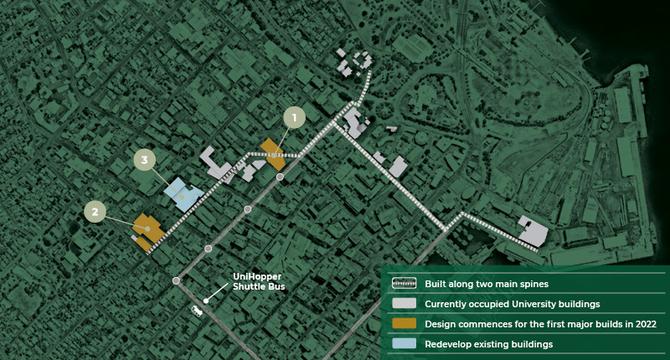It doesn’t take long for any conversation about living in Hobart to get to the issue of parking and congestion in the CBD.
For some, the move of the University to the city is seen as compounding this issue, so I wanted to explain the steps that the University is taking to ease parking and congestion in the Hobart CBD.
First – regarding the old Forestry Building in Melville Street, which we are repurposing and bringing back to life.
Once complete, this redevelopment will house some 300 staff and 3000 students.
While this will mean some increase in the numbers of people in the city, almost of all these students and many of the staff are already working and studying in the CBD. Additionally, our timetabling of classes will mean that only a small number of these will be using the Forestry Building at any one time, and most classes are outside of the peak traffic periods.
Planning is now underway at both the old Websters site, which can accommodate up to 400 parking spaces, and the former K&D site, which could house up to 800 spaces – all underground, which will support the University’s needs in Forestry and other future buildings.
...we have potential capacity for some 1600 to 1700 additional spaces in the city, compared to the approximately 1000 we have currently at Sandy Bay.
In addition to this, the University has parking capacity under our student accommodation building in Elizabeth Street just metres down the road, and on other sites across the city. In fact, all up, we have potential capacity for some 1600 to 1700 additional spaces in the city, compared to the approximate 1000 we have currently at Sandy Bay. We know from our modelling and staff and student travel surveys that this is far more than we will need when we have all of our operations in the city.
Importantly, these new parking spaces will be built in such a way as to ensure they can be converted to other uses in the future as commuting patterns to the CBD change.
In the interim, we can support the Forestry building through parking spaces at the old Websters building on the corner of Melville and Argyle Streets, the capacity under the student accommodation building, as well as through the existing park and ride service to and from our Sandy Bay campus.

1 - up to 400 spaces at the Library and Humanities; 2 - up to 800 spaces at Science and Engineering; 3 - demand for Business, Law and Admin managed by structured timetabling.
Second – regarding the impact of the movement of the Sandy Bay campus to the city.
Our research and modelling have identified that this will decrease congestion around Hobart.
While some three quarters of staff who work at the Sandy Bay campus take their vehicle to work each day, when they move to the city, this figure falls to about 50 per cent, demonstrated consistently through 10 years of our travel surveys.
That is because for many, the CBD gives people more options - it requires a single journey on public transport, and it opens the safe bike paths for walking or riding or using the new ferry. Currently, unless they live in Sandy Bay or Taroona, staff and students are required to move through the city to get to the Sandy Bay campus.
Additionally, with the bulk of the student accommodation now in the city, many more students will be able to walk, bike or scooter to the campus, or to work within the city.By moving the campus to the CBD, cross-city traffic will be reduced, meaning less congestion as traffic attempts to move across the bottlenecks of Davey and Macquarie Streets
By moving the campus to the CBD, cross-city traffic will be reduced, meaning less congestion as traffic attempts to move across the bottlenecks of Davey and Macquarie Streets in order to get to and from the Sandy Bay campus.
In addition to these initiatives, we are currently investigating the use of smart technology for flexible, bookable parking that has been used around the globe for years.
With this approach we can enable people to make daily choices without having to pay for expensive monthly commitments, but also enable the public to use the parking as well.
And we’re working closely with the City of Hobart and Tasmania’s Department of State Growth – including around Park and Ride facilities – to ensure all our parking initiatives help, and don’t hinder, their planned improvements.
We are confident of easily accommodating the parking requirements of staff and students in the city, while contributing to a long-term reduction of traffic congestion in Hobart’s CBD.DAVID CLERK IS THE CHIEF OPERATING OFFICER OF THE UNIVERSITY OF TASMANIA